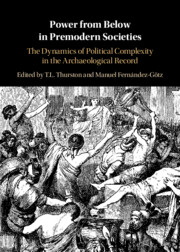 Power from Below in Premodern Societies
Power from Below in Premodern Societies Book contents
- Power from Below in Premodern Societies
- Power from Below in Premodern Societies
- Copyright page
- Contents
- Figures
- Contributors
- Preface
- One Power from Below in the Archaeological Record
- Two Fragmenting Trypillian Megasites
- Three Structure and Agency
- Four Power Requires Others
- Five “And Make Some Other Man Our King”
- Six Societies against the Chief? Re-Examining the Value of “Heterarchy” as a Concept for Studying European Iron Age Societies
- Seven Peasants, Agricultural Intensification, and Collective Action in Premodern States
- Eight The Spread of Scribal Literacy in Han China
- Nine Confronting Leviathan
- Ten The Emergence of Monte Albán
- Eleven Dispersing Power
- Twelve The Perplexing Heterarchical Complexity of New Guinea Fisher-Forager Polities at Contact
- Thirteen Restoring Disorder
- Index
- References
Nine - Confronting Leviathan
Some Remarks on Resistance to the State in Precapitalist Societies: The Case of Early Medieval Northern Iberia
Published online by Cambridge University Press: 08 October 2021
- Power from Below in Premodern Societies
- Power from Below in Premodern Societies
- Copyright page
- Contents
- Figures
- Contributors
- Preface
- One Power from Below in the Archaeological Record
- Two Fragmenting Trypillian Megasites
- Three Structure and Agency
- Four Power Requires Others
- Five “And Make Some Other Man Our King”
- Six Societies against the Chief? Re-Examining the Value of “Heterarchy” as a Concept for Studying European Iron Age Societies
- Seven Peasants, Agricultural Intensification, and Collective Action in Premodern States
- Eight The Spread of Scribal Literacy in Han China
- Nine Confronting Leviathan
- Ten The Emergence of Monte Albán
- Eleven Dispersing Power
- Twelve The Perplexing Heterarchical Complexity of New Guinea Fisher-Forager Polities at Contact
- Thirteen Restoring Disorder
- Index
- References
Summary
Spanish singer-songwriter Javier Krahe once described the 20th century as “a total disgust”: “According to those who experienced it, last century was a hell of a traumatic experience.”1 Indeed, the twentieth century was fraught with disturbing experiences where the worst side of human beings showed its ugly head (Hobsbawm, 1994). And yet, this “disgust” of a century has also provided repeated evidence that, even in the most extreme situations, groups of people have somehow managed to articulate their collective agencies, often in the form of resistance, and even generated counterpowers from below (De León, 2015; Moore, 1993; Scott, 1985; Wolf, 1973).
- Type
- Chapter
- Information
- Power from Below in Premodern SocietiesThe Dynamics of Political Complexity in the Archaeological Record, pp. 202 - 219Publisher: Cambridge University PressPrint publication year: 2021
References
- 2
- Cited by


